I have edges of a network:
var links = [
{source: "A", target: "D", type: "high"},
{source: "A", target: "K", type: "high"},
{source: "B", target: "G", type: "high"},
{source: "H", target: "B", type: "high"},
{source: "C", target: "A", type: "low"},
{source: "C", target: "L", type: "low"},
{source: "E", target: "A", type: "low"},
{source: "F", target: "B", type: "low"},
{source: "F", target: "G", type: "low"},
{source: "K", target: "J", type: "low"},
{source: "F", target: "I", type: "low"},
{source: "G", target: "H", type: "low"},
{source: "E", target: "K", type: "high"},
{source: "E", target: "G", type: "low"},
{source: "E", target: "F", type: "high"},
{source: "E", target: "M", type: "high"},
];
From which I compute the nodes:
var nodes = {};
links.forEach(function(link) {
link.source = nodes[link.source] || (nodes[link.source] = {name: link.source});
link.target = nodes[link.target] || (nodes[link.target] = {name: link.target});
});
I want to change opacity of nodes and edges when connected. I have a function to grab all the links/edges:
var linkedByIndex = {};
links.forEach(function(d) {
linkedByIndex[d.source.index + "," + d.target.index] = 1;
});
I can then use this function to check all edges that are connected and e.g. change opacity of all those connected to a node:
function isConnected(a, b) {
return linkedByIndex[a.index + "," + b.index] || linkedByIndex[b.index + "," + a.index] || a.index == b.index;
}
function fade(opacity) {
return function(d) {
node.style("stroke-opacity", function(o) {
thisOpacity = isConnected(d, o) ? 1 : opacity;
this.setAttribute('fill-opacity', thisOpacity);
return thisOpacity;
});
....etc.
This is here as a live example.
What I would like to do however is to return those edges that are part of a triad.
Therefore in the above diagram, if "E" was hovered, the edges E-A, E-K, A-K, as well as E-G, E-F and F-G would be returned. If "H" was hovered over, then H-G, H-B and B-G would be returned.
My aim is to highlight the triads belonging to each node. Importantly, I do not want incomplete triads. i.e. if "C" is hovered over, then it wouldn't select C-A and C-L as the triad is not closed with A-L.
